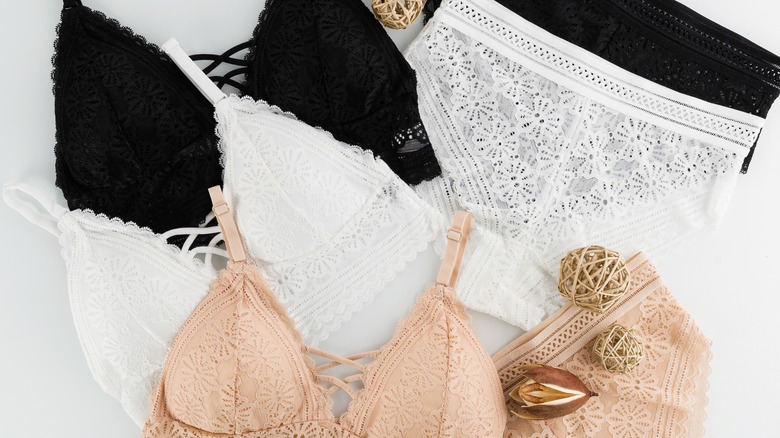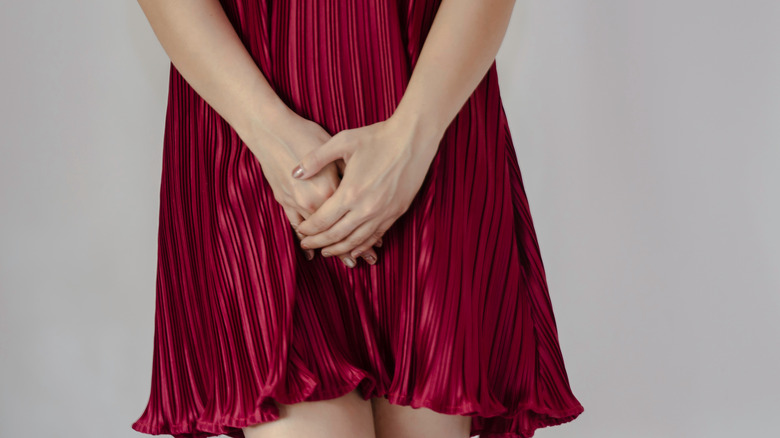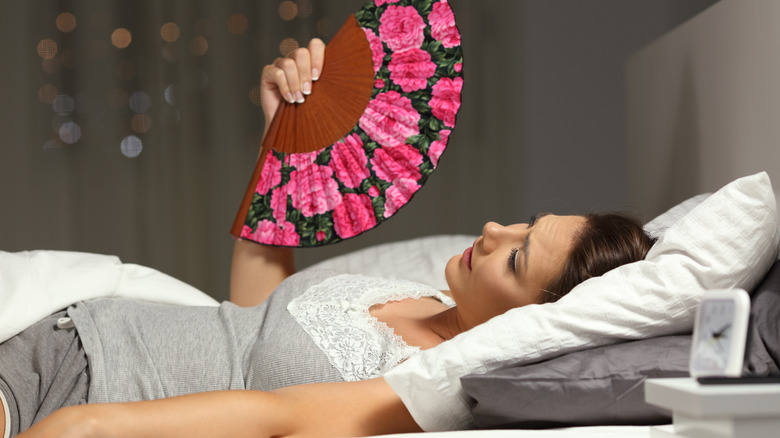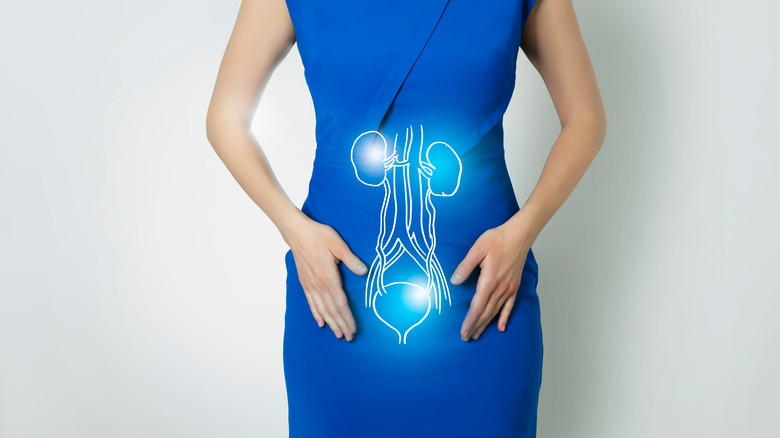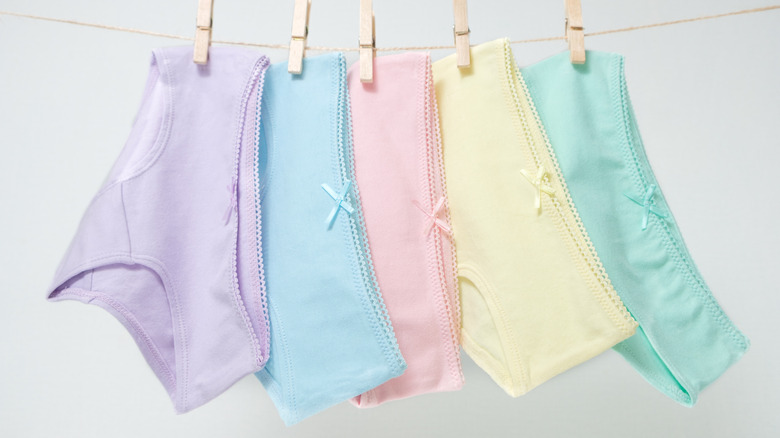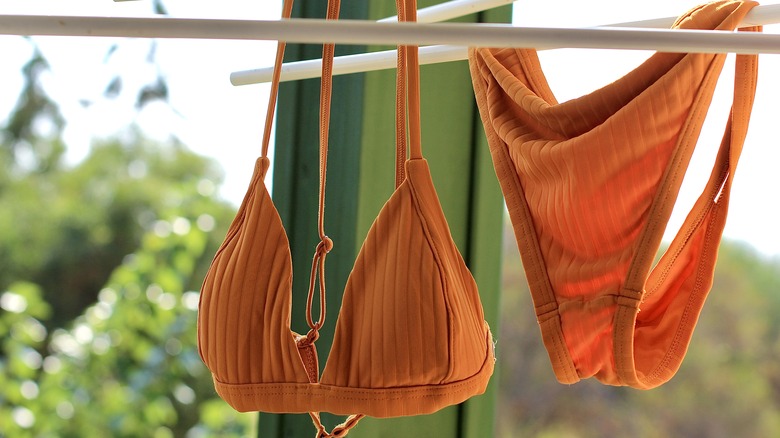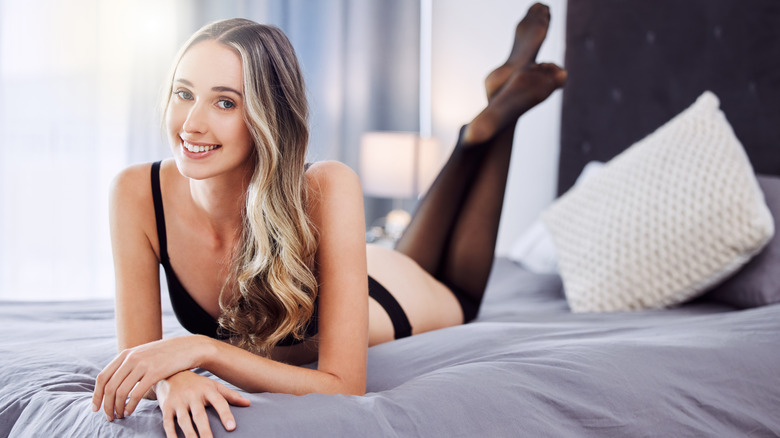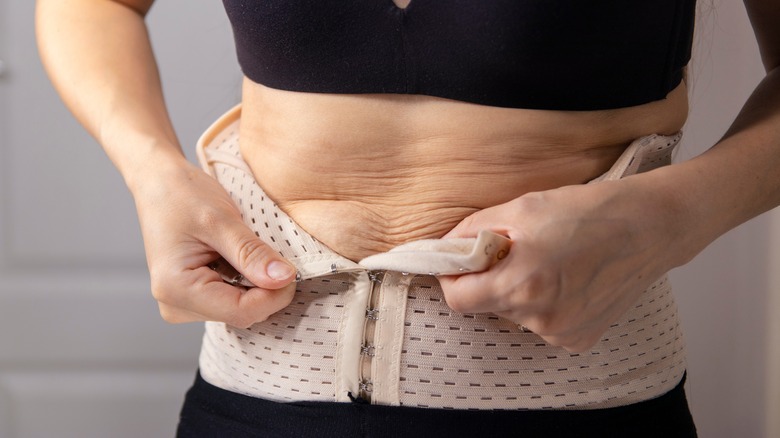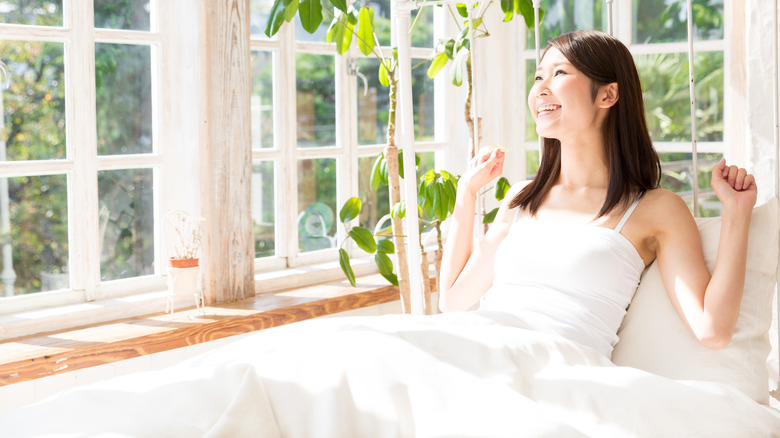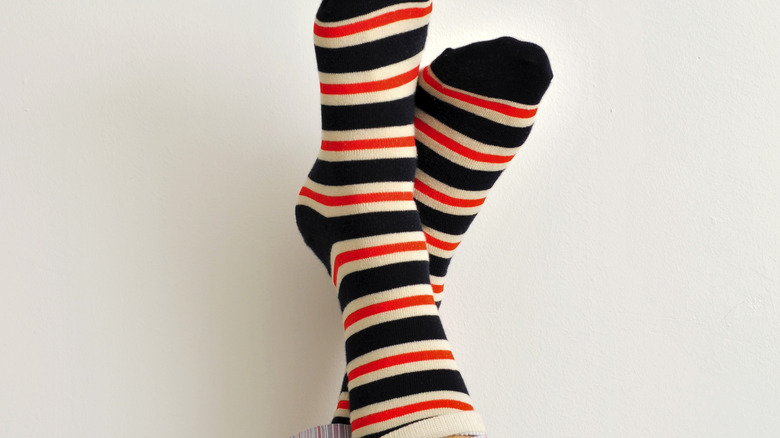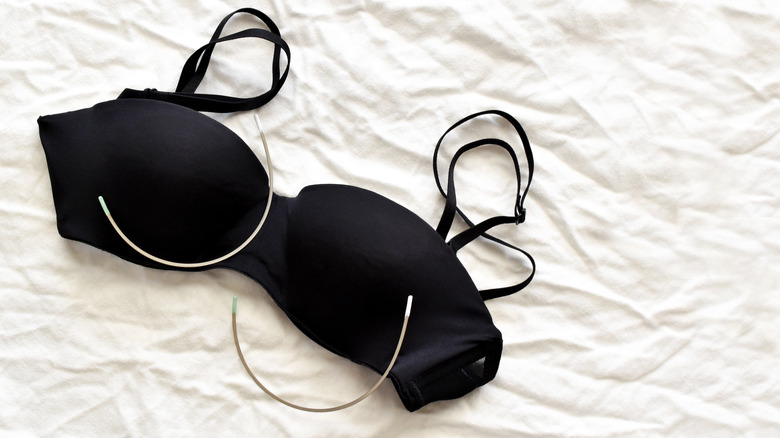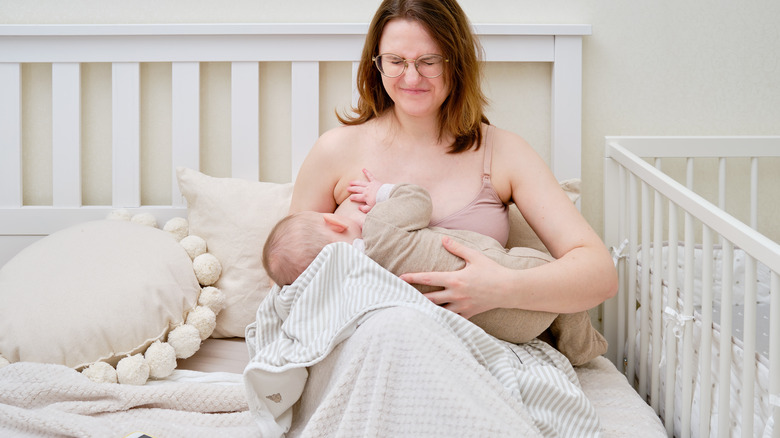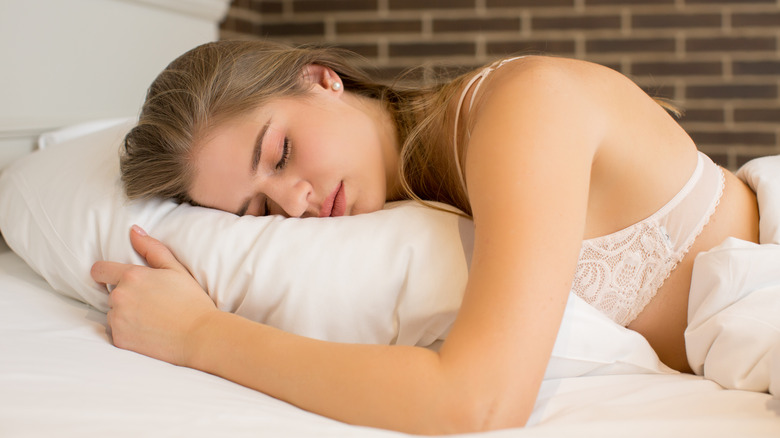What Really Happens To Your Body If You Sleep In Your Underwear
You want to feel comfortable, relaxed, and cozy when you sleep. This could mean dressing up in your favorite sleepwear, wearing just undergarments alone, or wearing nothing at all. In fact, when it comes to sleep, wearing fewer clothes has its merits. Per Healthline, sleeping naked could help you fall asleep faster and improve your sleep quality. Good sleep is known to improve skin health, lower stress and anxiety levels, and prevent weight gain amongst other things.
Besides being cute and coming in various fabrics, styles, and colors, undergarments also have a functional purpose. Your panties, for example, protect the sensitive skin around your vagina from whatever outfit you choose to wear. They also protect your clothes from fluids that come out of that area. Plus, there's the right pair for every need; whether you want to feel sexy and confident or just want to secure your pad or panty liner (via Healthnews). But is it okay to sleep in your undergarments, such as your panties and bras? And what actually happens if you do?
You can breed bacteria and fungi
Bacteria and yeast, which are the causes of most vaginal infections, love warm, dark, and moist places, according to obstetrician and gynecologist Alyssa Dweck, who spoke to Live Science. They grow and multiply in these conditions and can increase your risk of getting an infection. Your vaginal area is subject to these conditions during the day due to tight, non-breathable clothing that causes you to sweat. Parting with your panties at night stops the suffocation for a while.
Not every woman who sleeps in panties is at risk of an infection, though. If you have a healthy vagina, then this should be a matter of preference, notes Healthline. However, your vagina area is worthy of fresh air just like any part of your body, obstetrician and gynecologist Alyse Kelly-Jones told the site.
On the other hand, women with chronic inflammation of the vulva or vagina are prone to vaginal infections, itchiness, and irritation, so they'll benefit from sleeping without panties, noted Dr. Dweck.
You may feel too hot at night
In addition to not allowing your genital area to breathe at night, wearing panties to sleep contributes to making you feel hot. Ditching them can help you feel cooler if you struggle with nighttime heat. Being cool also helps you sleep better because your body sees a lower internal or core body temperature as a signal to initiate sleep. A low internal body temperature also improves your brain's ability to get rid of toxins, which is a normal activity that happens during deep sleep. These toxins hamper the brain's signaling with the rest of the body. Without clearing them, your cognitive capabilities and creativity might be dampened the next day (via SofZZSleep).
While you try to avoid getting hot during sleep, you also want to make sure you don't get too cold. Per the Sleep Foundation, your body's temperature can easily change in response to room temperature fluctuations while you sleep. Getting too cold can affect your sleep, and you run this risk especially if you sleep nude. If you choose to go commando, maintain a room temperature between 66 and 70 degrees Fahrenheit and use covers to find the right balance of comfort while you snooze.
You are more prone to UTIs
There are standard practices that help you prevent urinary tract infections (UTIs) from sex — peeing before sex, peeing after sex, and washing your vagina area with warm water. But how does one get UTIs from sex in the first place? These infections, per Healthline, happen when bacteria from your genitals get into your urinary tract — your urethra, bladder, ureters, and kidneys — and infects it. This bacteria can be transferred to your urinary tract during oral or penetrative sex.
So how does sleeping panty-free after sex help? By airing out your genital area, that's how, according to PureWow. While having sex, there are a lot of fluids produced and exchanged. And when you sleep, your vagina will likely produce more fluids and the surrounding skin can sweat. This means that the area will likely be very moist. And wearing panties will trap all that moisture and create a favorable environment for the infection-causing bacteria to thrive. Utiva advises that you sleep without panties more often if you're prone to UTIs.
Cotton panties are preferable for nighttime wear
There, of course, are times when sleeping without panties might not always be ideal. Many women sleep better knowing that they have their period panties on while menstruating. When you can't sleep without them, cotton panties are the preferable choice of underwear (via RenewLife).
Why cotton? Healthnews explains that the fabric allows airflow to the vagina, keeping it cool and dry, and preventing bad odors. Cotton panties are also hypoallergenic because they are made with few dyes and chemicals. Bamboo panties are also a good option. This material keeps you dry because it's breathable, moisture-wicking, and absorbent. It's also made with antifungal and antibacterial agents that prevent bad odors. Synthetic materials like nylon and spandex trap moisture which can lead to irritation of the vagina and vulva and increase the risk of infections.
Your panties should also fit properly, meaning not too tight, as you run the risk of overall discomfort, chafing, and developing ingrown hairs if they are.
Wet panties promote bacteria growth
The moist environment wet panties create promotes the growth of harmful microbes, increasing your risk of yeast infections (via Norton Healthcare). Your panties can get wet from pretty innocent things — a hot bath, swimming, or from sweat after a good workout. It could also come from not wiping yourself properly after using the toilet, urinary incontinence, or excessive vaginal discharge, per Health Shots.
Leaving wet panties on, even just occasionally, is not part of proper underwear hygiene. Wet panties are uncomfortable and can irritate the sensitive skin around the vagina causing redness and rashes. They also make the groin area itchy and smelly and could mess up the pH of your vagina. Plus, yeast infections come with unpleasantness — vaginal irritation, a strong urge to itch, and pain while urinating and during sex. Therefore, it's best to get out of wet panties swiftly and not sleep in them to avoid this.
You should avoid thongs at night
Wearing thongs can be useful at times. You don't have to worry about annoying panty lines and your butt won't be caged in by fabric. This makes some women feel confident and sexy. Other women are not convinced. There are concerns that wearing thongs will shift harmful bacteria from the anus to the vagina. But as long as the string part is kept clean and you wipe properly after a bowel movement, you should be safe from that worry, according to obstetrician and gynecologist Corey Babb (via Giddy).
Unfortunately, this does not prevent friction from the string when you move about at night. That friction can cause little tears in your skin that can become breeding holes for microbes, obstetrician and gynecologist Ronald Blatt told Vice. This situation can be made even worse if your thong is made of materials that retain moisture and create a favorable environment for the growth of these organisms. Tight thongs also cause rashes and skin tags, can and irritate hemorrhoids, noted Dr. Blatt.
Thongs are better off being worn occasionally, and not to bed. But if you must sleep in them, Blatt advises you to opt for cotton ones.
Waist trainers can restrict breathing
There are many reasons people wear waist trainers — to fit into clothes better, to activate core muscles, or to simply boost confidence. Waist trainers are also used by individuals with conditions such as scoliosis, asthma, osteoporosis, and hypermobile joints, although these instances are typically under the supervision of a medical professional.
Waist training for aesthetic purposes alone has its risks, which include shifting internal organs, breathing issues, skin irritation, bruising, numbness, and acid reflux, among other things. While the idea of getting an hourglass figure by enduring a waist trainer can be appealing to some, it has yet to be proven that the promised benefit is real (via MyMed.com).
The medical community advises against using waist trainers at night, notes Healthline. Doing so could put you in a vulnerable position by causing discomfort during a time when you should be relaxed. It could also suffocate you by restricting your breathing and cause acid reflux, problems digesting food, lymph flow restriction, and organ malfunction.
Camisoles double as sleepwear
For folks who would rather not sleep commando, there's a variety of sleepwear on the market to bring comfort for a good night's sleep. Some folks love getting kitted up in pajama tops and bottoms. Some enjoy their old baggy T-shirts. Some prefer fancy nightgowns. Others choose to sleep in their camisoles.
Camisoles can easily double as sleepwear as they are sleeveless and flow loosely around the waist, allowing you to move about freely (via Durfi). Additionally, wearing a camisole can feel very close to sleeping naked if you aren't comfortable treading into that territory yet. Because camisoles usually come in soft and stretchy materials, they won't feel so stuffy. And their spaghetti straps and shorter lengths allow you to get proper airflow if you tend to get hot at night easily. They also come in different materials, colors, and designs, meaning they don't have to be boring (via Sleepopolis).
Socks do more than keep you warm
You might think that wearing socks at night will drive up your core temperature, but the opposite is the case. Wearing socks reduces your core temperature through a process known as distal vasodilation (per Bettersleep). Wearing socks warms up your feet which causes blood vessels there to dilate or widen. The dilated blood vessels dispel heat through your skin and this lowers your internal temperature. But if your feet are cold, your blood vessels constrict to retain heat.
Wearing socks to sleep also has other benefits. Doing so improves circulation, reduces the frequency of hot flashes in menopausal women, warms the feet of people with Reynaud's disease, helps prevent cracked heels, and may even help women orgasm, according to Healthline.
The kind of socks you wear matters. According to Bettersleep, loose, breathable, clean, and fresh socks are preferable. Tight socks could restrict blood flow and non-breathable fibers won't allow your feet to release heat. Opt for cotton, cashmere, or merino wool fabrics.
Avoid underwire or tight bras
During the day, underwire bras can perform magic on your boobs and really bring an outfit together, but they won't do much for you at night. These bras, due to their design can make you feel caged-in and uncomfortable, and can irritate and even injure your skin when there's friction during sleep. According to Francine Queen of Threads, friction also stimulates melanin production so you run the risk of getting dark spots or "bra burns" if you wear a tight bra all night.
Tight, underwire bras can also restrict blood flow to your arms, breasts, and other body parts. This could lead you to experience muscle cramps and dizziness. Wearing tight or underwired bras to sleep can even affect the movement of lymph nodes which are located around your armpits to carry toxins away from the breasts. Blocked lymph nodes can lead to edema (swelling), long-term inflammation, and other problems (via Flo Health).
Nursing bras can be most comfortable for new moms
Whether a nursing mother should sleep in a bra depends on her personal comfort and preference. During pregnancy, the breasts can get heavier and larger as breast milk starts coming in. This heaviness continues during the first two to six weeks of breastfeeding. Many moms opt for wearing nursing bras at night due to backaches from their larger breasts and because of milk leaking (via La Leche League International).
During this time, tight and underwire bras should be avoided. These types of bras put too much pressure on the enlarged breasts and can lead to swelling from blocked ducts and mastitis, which is a painful inflammation of the breasts, according to La Leche League International.
If wearing a bra is not your speed, there are other fixes for leaky breasts at night. You can place a towel or cloth under your breasts or use them when milk leaks out. Per Mommy and Love, nursing tank tops and braless nursing pads are also an option. Your breast milk production won't be affected whether you wear a bra or not. If you're concerned about milk production, you should speak with your healthcare provider.
Choose these bras if you want to sleep in them
Some women do benefit from sleeping in a bra because of the structure it offers. These include women who experience breast pain at night or women who wish to restrict breast movement because they have large breasts (via Healthline). If you need to sleep with a bra on, you should choose a properly fitting one that tucks well under the breasts and is not too tight, has no underwire, and is made with a breathable fabric like cotton. It's also important to wash your bras often to get rid of germs, oil, and sweat so as to prevent skin problems.
There are common myths about the effects of wearing a bra to sleep, such as doing so increases your risk of breast cancer and could your breasts' growth, but these should be dismissed. There's no medical evidence to back up these claims, according to Healthline.
On the other hand, some women believe sleeping in a bra can prevent breasts from sagging (via Healthline). This is another misconception. The ligaments holding the breasts up stretch naturally as you get older. This process is also influenced by your genes, gravity, menopause, pregnancy, breastfeeding, and weight fluctuations. Sleeping with a bra on won't stop the fall. Instead, working on your pectoral muscles can slow down breast sag.
